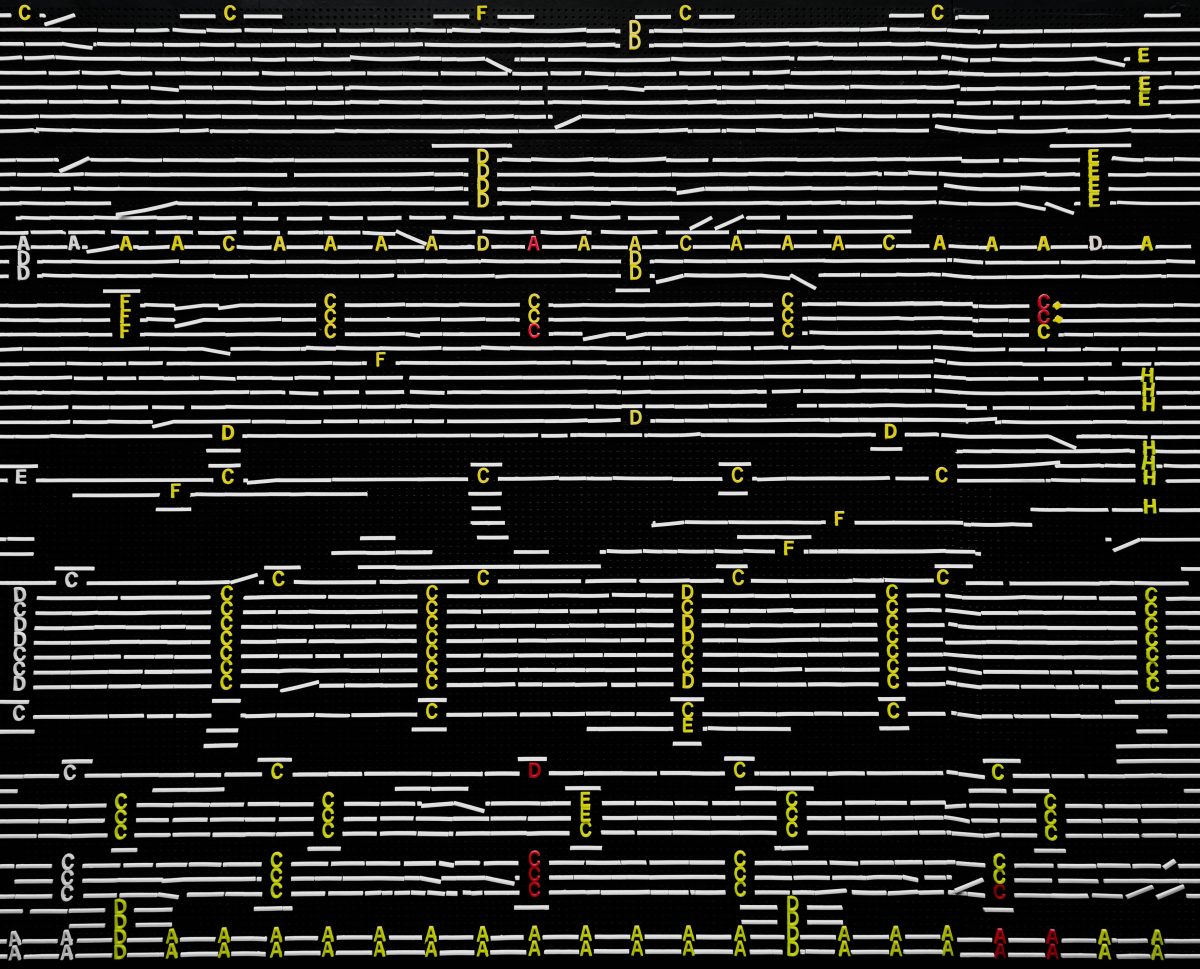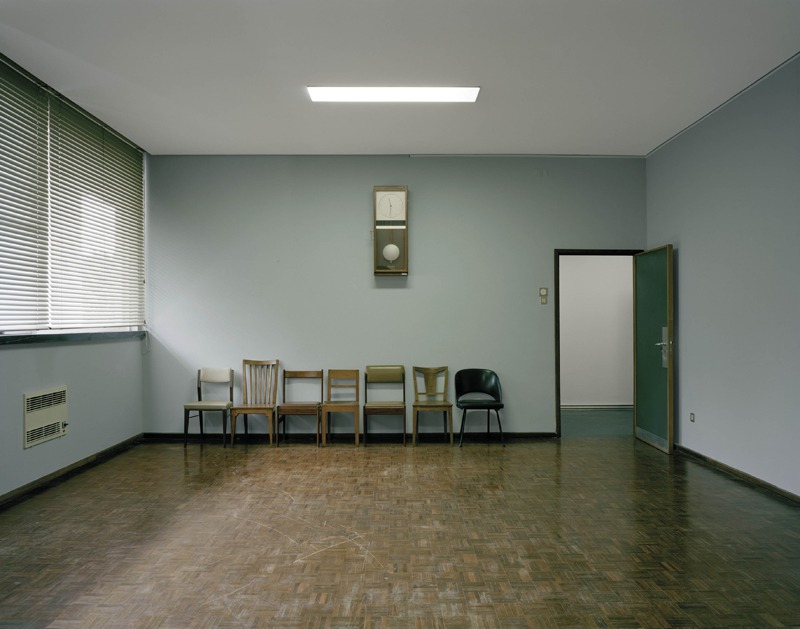-
work /
The Time Machine, 2011
Shot between 2010 and 2011, The Time Machine is structured as a topographic survey of hydro-electricity generating plants.
Working closely with the EDP Foundation, I gained exclusive access to 20 power plants located across Portugal. Many of the power stations were built between the 1950’s and 1970’s, a time of hopeful prospects of rapid economic growth and social change. Their tacit raison-d’être was to fuel the country’s expansion and propel it into a prosperous future.Forty years on, no more than half a dozen people, including specialists and cleaning and security staff, run places which, in some cases, were intended to house up to 250 workers just a few decades ago. These people and their families were intended to live in real villages, hubs of population and urban development in a future which, today, has ultimately emerged as uninhabited.
At each dam, computerised mechanisms now regulate the production and distribution of energy. This has alienated the concrete and immediate power by which reality is governed and concentrated the control of a complex hydroelectric system in a distant centre (thus lending consistency to the fantasy of machines ruling over man).
Although the power stations were conceived at a time when man and machine envisaged a shared future, today, the desertification of the technical sites which house the machines (as well as the natural and human landscapes where the dams were constructed), allude to the paradox of this impossibility.
Whilst the work in no way seeks to deny the role that these power stations may have played in the economic development of Portugal, the photographs are tense with unfulfilled expectations.
The Time Machine records objects and spaces whose grand and progressive designs testify of the scope and ambition of the vision they were built to serve. These machines and rooms, which simultaneously place us in genuine science-fiction settings and in an unavoidable field of nostalgia characterise a suspended time, that of the modern.In recovering a past of exciting technological innovation and optimistic belief in the future, these photographs suggest that they are not just about the generation of power but also of dreams and technological utopias. Because the future announced there is here now; and now we know that nothing has happened in the way that the ideological narrative of the modern wanted us to believe that it would.
-

Vila Nova power station: chart for scheduling the periodic maintenance of the generating sets
-

Caldeirão Dam: water intake tower for hydraulic circuit
-

Bemposta power station: circular dam gallery
-

Bemposta power station: circular dam gallery
-

Alto Rabagão power station: busbar shaft (view from the machine hall)
-

LSXAV cable with lead sheath and tar coating 2 x 4mm, multi-strand
-

VAV cable with steel band and earth network 3 x 2.5 mm
-

Miranda power station: return-gate chamber
-

Pocinho power station: dam discharge gallery
-

Pocinho power station: dam discharge gallery
-

Frades power station: GIS substation (gas insulated substation or switchgear)
-

Bemposta power station: access gallery to the dam
-

Miranda power station: machine hall
-

Picote power station: emergency diesel generating set
-

Pocinho power station: cooling water filtering system (1st level) of a generating set
-

Alto Lindoso power station: instrument transformer cell in the busbar gallery (alternating-current generator floor)
-

Picote power station: busbar gallery (15kV busbars). Note: in the centre of the photo one can seen an excitation rheostat for the generating sets (spare part)
-

Lifting bolt used to disassemble the generating sets, 1Kg, 40 x 220 mm
-

Lindoso power station: control room
-

Fratel power station: machine hall
-

Raiva power station: hydropower panel in the control room
-

Alto Lindoso power station: control room
-

Alto Rabagão power station: waiting room
-

56mm-open end spanner (custom-made tool), with various uses for turbine equipment, 1Kg, length 380mm
-

Miranda power station: DC switchboards
-

Alqueva power station: DC switchboards
-

Tool—hex box spanner—used to disassemble the turbine, 8 kgs, hexagonal interior 80 mm, length 380 mm
-

Vila Nova power station: transformer cooling control panel
-

Picote power station: chronological event recorder interface cabinet
-

Vila Nova power station: battery room (emergency generating set)
-

Vila Nova power station: cable room
-

Tool for testing turbine aeration valves, 2 Kg, 240 x 240 mm
-

Tool—hex box spanner—used to disassemble the generating sets, 1Kg, hexagonal interior 50mm, length 290mm
-

Miranda power station: office
-

Alto Rabagão power station: meeting room
-

Miranda power station: control room
-

Cable with steel band and earth network 2 x 1.5 mm
-

-

Picote power station: 1st floor landing stage of the control building
-

Bemposta power station: machine hall
-

Threaded socket, used to join suspension shafts in the return gates of the generating sets, 15 kg, 355 x 100 mm
-

Screw for lifting the cover off the distributor ring, 15 Kg, 66 x 660 mm
-

Vila Nova power station: chart for scheduling the periodic maintenance of the generating sets
-

Belver power station: access corridor to the control room
-

Vila Nova power station: auxiliary generating set control panel
-

Vila Nova power station: machine hall
-

Valeira power station: machine hall
-

Support chock (custom-made tool), used when dismantling the servomotors of the outlet stop logs of the generating sets, 5Kg, 500x100x100mm
-

Custom-made tool, used for assembling and disassembling the magnetic poles of the alternator rotor, 5 kg, 190 x 160 mm
-

Pocinho power station: equipment unloading dock (view from the machine hall)
-

Aguieira power station: 12kV monoblock unit, entrance door to oil analysis room
-

Aguieira power station: 12kV monoblock unit, entrance door to oil analysis room
-

Alqueva Dam: view of the Alqueva reservoir



















































